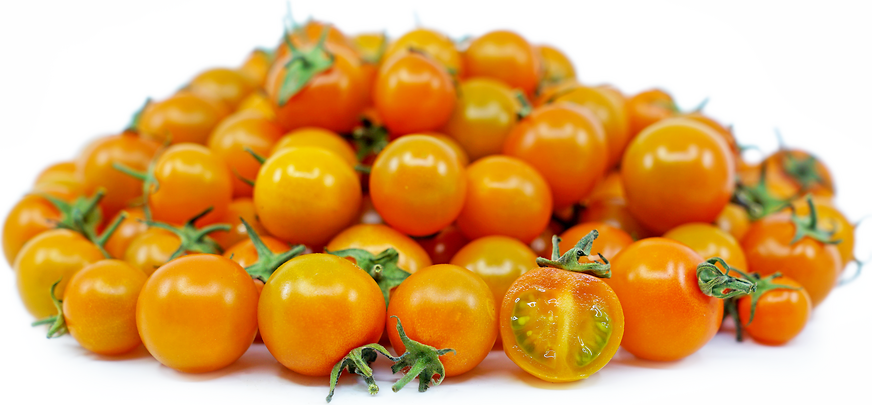


Orange Cherry Tomatoes
Estimated Inventory, 12 ct : 0
Description/Taste
Orange cherry tomatoes, like many cherry tomato varieties, are smaller and sweeter than large tomatoes, however they are distinguished by their orange complexion, resulting from a mutation. The recessive mutant allele is referred to as “tangerine,” named for the orange fruit variety where the gene was first discovered. This mutation causes a build-up of the orange pigment prolycopene, and results in the unique coloration of the tomato. Orange cherry tomato plants are classified as an indeterminate variety as they are long, sprawling vine plants that bear fruit continuously throughout the season. The plants are extremely abundant, producing high-yield clusters of the cherry-sized, sweet and flavorful tomatoes.
Seasons/Availability
Orange cherry tomatoes are available in the summer and in the fall.
Current Facts
Tomatoes are botanically referred to as Lycopersicon esculentum, although modern studies are encouraging a return to the original classification, Solanum lycopersicum. Tomatoes are further classified by subgroups representing variations within the tomato species, thus cherry tomato varieties are more specifically called Lycopersicon esculentum var. cerasiforme. The majority of the tomato’s DNA remained a mystery until the recent decade when a group of plant geneticists from fourteen different countries collectively decoded the tomato genome. The results have revealed that tomatoes contain 31,760 genes, roughly 7,000 more than humans. While conclusions can now be more definitively made about coloring, shape and evolution, such as for the Orange cherry tomato and its “tangerine” mutation, some mysteries do remain, and scientists still have a lot to learn about the tomato species and its cultivars.
Nutritional Value
Cherry tomatoes have significant amounts of vitamin C and Vitamin A, which supports eye health and aids your body in producing white blood cells to keep your heart, lungs and kidneys working properly. Tomatoes are also known for being rich with anticancer phytochemicals, most notably lycopene. The shielding effects of tomatoes against some types of cancer, as well as cardiovascular disease, result from the synergy of lycopene with other phytonutrients naturally present in the tomatoes.
Applications
With their inherently sweet flavor, Orange cherry tomatoes are great for eating fresh, but they can also be used in nearly any recipe that calls for cherry tomatoes. Cooking the tomatoes just until the start of burst will intensify their sweetness while preserving some of their texture. Orange cherry tomatoes add a pop of color and flavor to a diversity of dishes, from salads, to pastas, to sauces. Tomatoes and cheese are a perfect pairing to top crostini for a summer snack. Try topping crostini with lightly broiled Orange cherry tomatoes and ricotta cheese, or toss the tomatoes with garlicky toasted bread cubes, olive oil, vinegar, and basil to make a summery panzanella.
Ethnic/Cultural Info
Mesoamerican farmers who began domesticating cherry tomatoes in northern Central America eventually selected mutated fruits for breeding, increasing the size, shape, and the number of seed cavities of the different cultivars. This evolution was essential in transforming the berry-sized, perfectly round wild tomatoes into the array of shapes and sizes of tomato varieties today.
Geography/History
Like all tomato varieties, Orange cherry tomatoes are descendants of the wild tomato, which has its origins in coastal South America, native primarily to Peru and the Galapagos Islands. It is believed that the tomato was first domesticated further north in Mexico because seeds were taken from there to Europe after Cortez conquered Mexico City in 1519. The first cultivated tomato fruits were roughly the size of berries, and their flesh only housed two seed cavities. Orange cherry tomatoes, in particular, have appeared in seed catalogs for over a century, yet there is no documented evidence citing their exact origin.
Recipe Ideas
Recipes that include Orange Cherry Tomatoes. One
Podcast




